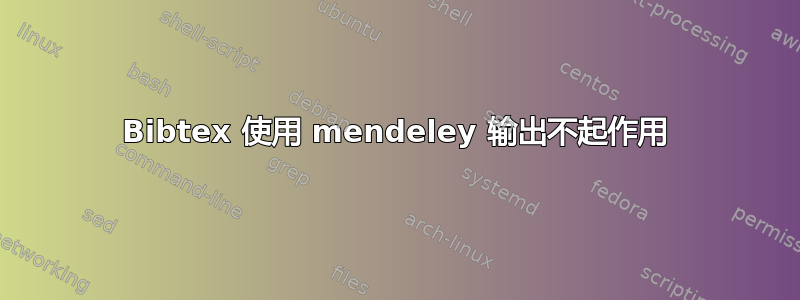
我的代码:
\documentclass[12pt,letterpaper]{article}
\usepackage[utf8]{inputenc}
\usepackage[spanish]{babel}
\usepackage{graphicx}
\usepackage{grffile}
\usepackage{fancyhdr}
\usepackage[bookmarks = true, colorlinks=true, linkcolor = black,
citecolor = black, menucolor = black, urlcolor = black]{hyperref}
\usepackage[left=3cm, right=3cm, top=2.5cm]{geometry}
\usepackage{apacite}
\usepackage{parskip}
\begin{document}
\renewcommand{\refname}{Bibliografía}
\bibliographystyle{IEEEtran}
\bibliography{documento.bib}
\label{biblio}
\nocite{*}
\end{document}
Document.bib(mendeley输出):
[
@article{Moreno2014,
author = {Moreno, Rodolfo G and Mart{\'{i}}nez, Mauricio A and Nakano, Mariko and P{\'{e}}rez, H{\'{e}}ctor M},
doi = {10.4067/S0718-07642014000500019},
issn = {0718-0764},
journal = {Informaci{\'{o}}n tecnol{\'{o}}gica},
number = {5},
pages = {137--146},
title = {{Desarrollo de Algoritmos para Muestreo Compresivo Aplicado a Se{\~{n}}ales de Audio}},
url = {http://www.scielo.cl/scielo.php?script=sci{\_}arttext{\&}pid=S0718-07642014000500019{\&}lng=en{\&}nrm=iso{\&}tlng=en},
volume = {25},
year = {2014}
}
@article{Patil1970,
abstract = {Audio compression has become one of the basic technologies of the multimedia age. The change in the telecommunication infrastructure, in recent years, from circuit switched to packet switched systems has also reflected on the way that speech and audio signals are carried in present systems. In many applications, such as the design of multimedia workstations and high quality audio transmission and storage, the goal is to achieve transparent coding of audio and speech signals at the lowest possible data rates. In other words, bandwidth cost money, therefore, the transmission and storage of information becomes costly. However, if we can use less data, both transmission and storage become cheaper. Further reduction in bit rate is an attractive proposition in applications like remote broadcast lines, studio links, satellite transmission of high quality audio and voice over internet},
author = {Patil, M. V. and Gupta, Apoorva and Varma, Ankita and Salil, Shikhar},
issn = {ISSN ONLINE(2319-8753)PRINT(2347-6710)},
journal = {International Journal of Innovative Research in Science, Engineering and Technology},
title = {{Audio and Speech Compression Using DCT
and DWT Techniques}},
year = {1970}
}
@article{Ambikairajah1997,
abstract = {In high-quality digital audio coding, a great deal of attention is focused on the auditory perception process, as the goal of audio compression is to attain perceptually-transparent compression and reproduction. Consequently models for perceptual masking are used extensively in audio coders, allowing quantisation noise to be allocated in the various frequency subbands according to a masking function. In this way, quantisation noise can be made almost inaudible at the receiver. In this paper, the psychoacoustic phenomenon of auditory masking is described. This is followed by a review of the MPEG-1 (Moving Pictures Experts Group) international standard for audio compression, including an outline of the psychoacoustic models used.},
author = {Ambikairajah, E. and Davis, A. G. and Wong, W. T.K.},
doi = {10.1049/ecej:19970403},
issn = {09540695},
journal = {Electronics and Communication Engineering Journal},
title = {{Auditory masking and MPEG-1 audio compression}},
year = {1997}
}
@inproceedings{Salau2019,
abstract = {In recent years, audio compression has become a very popular area of research. Today, innovations in audio signal processing are used in numerous applications which include advanced audio coding (AAC), perceptual audio coding schemes (MP3 encoding), internet radio and other lossless audio coding schemes. This paper proposesan algorithm for the compression of audio signals using Discrete Cosine Transform (DCT) with temporal auditory masking (TAM). Furthermore, we have developed a system for audio data compression and evaluated the proposed algorithm using its compression ratio (CR), peak signal to noise ratio (PSNR) and transmission delay (TD). The experimental results show that the proposed algorithm gives a compression ratio (CR) of 4:1 of the original signal. All the simulations are carried out using Octave Signal Processing Tool kit and the codes are written in Octave with C programming language.},
author = {Salau, Ayodeji Olalekan and Oluwafemi, Ifetayo and Faleye, Kehinde Felix and Jain, Shruti},
booktitle = {2019 International Conference on Signal Processing and Communication, ICSC 2019},
doi = {10.1109/ICSC45622.2019.8938213},
isbn = {9781538694367},
keywords = {Audio compression,compression ratio,discrete cosine transform,temporal auditory masking,voice},
title = {{Audio Compression Using a Modified Discrete Cosine Transform with Temporal Auditory Masking}},
year = {2019}
}
]
错误:
! Undefined control sequence.
<argument> \@listctr
l.24 \bibitem{Moreno2014}
?
! You can't use `\relax' after \the.
<recently read> \c@
l.24 \bibitem{Moreno2014}
?
! Undefined control sequence.
<argument> \@listctr
l.33 \bibitem{Patil1970}
?
! You can't use `\relax' after \the.
<recently read> \c@
l.33 \bibitem{Patil1970}
...
答案1
您正在加载 apacite包,但未使用关联的 bibtex 样式。因此所做的更改apacite与 bibtex 输出不兼容。
解决方案:不要加载您未明确使用的包。
提示:在每个已加载的包上方留下一条小评论,解释一下您使用它的原因通常是一个好主意。


